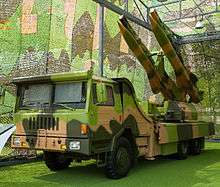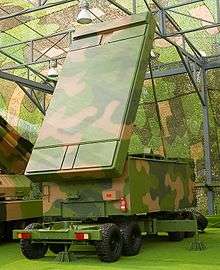KS-1 (missile)


The Kai Shan - 1 (KS-1) (凯山一号) is the first Chinese surface-to-air missile to adopt a phased array radar.
Design
The KS-1 missile was developed for the PLA as a replacement for the HQ-2, itself a reverse-engineered copy of the Soviet S-75 Dvina and used the same command guidance and SJ-202 Fan Song engagement radar along with what appears to be a HQ-2 single-rail launcher adapted to twin rails for the more compact KS-1 missile. This launcher could be mounted on a 6x6 truck to increase system mobility or be emplaced in the standard fashion.
KS-1A is the updated version, roughly the Chinese equivalent of the American MIM-23 HAWK, except it was designed to engage missiles as well as aircraft. This unique design feature means that it is the first Chinese SAM to adopt an indigenous planar passive phased array engagement radar, designated the H-200, which can simultaneously track multiple targets 100+ km away, it can guide six missiles to three targets at the same time (two missiles at each target). The new radars substantially improve the systems performance over the original KS-1.
Development
The first successful test-firing of the missile was in 1989; KS-1 development was complete in 1994. The missile was first publicized in 1998 at the Zhuhai airshow. An improved version, the KS-1A, which greatly enhanced its minimum altitude and range, has already been developed and first appeared at the sixth Zhuhai airshow in 2006. It was rumored that this improvement also increased its ability to engage targets maneuvering at a higher g force.
History
The People's Liberation Army (PLA) preferred to wait for the improved model, the KS-1A, which has better performance, thus the KS-1 was only delivered to the Chinese armed forces in very small numbers for evaluation purposes. However, due to more advanced SAM systems being available, such as the HQ-16 and the HQ-17, it is unlikely that the PLA would ever purchase the KS-1A, the fate of both missiles is uncertain.
Both the KS-1 and the KS-1A are offered for export.
Components of the KS-1A system such as the modern planar array engagement radars could be used for upgrading legacy HQ-2 and S-75 systems, dramatically improving their performance.
Deployment
Standard deployment of a KS-1A SAM battery typically includes:
- 1 Planar Passive phased array radar (PPAR)
- 4 launchers, each with 2 missiles
- 24 missiles
- Other support equipment
Variants
- KS-1: The initial version with a SJ-202 engagement radar, which adopts a simple horn instead of a lens arrangement, the missile seeker has a traditional parabolic antenna, and can guide up to two missiles against one target. Range is in excess of 40 km. The KS-1 resembles the US SM-1 or SM-2 Standard.
- KS-1A: A KS-1 development, with a Cassegrain antenna for the seeker, and the option of the towed H-200 planar array PPAR or mobile SJ-231 planar array PPAR, which can guide up to eight missiles against four targets (two missiles for each target) simultaneously.[1] The SJ-231 radar adopts a more complex lens arrangement like that of the MPQ-53 radar of the MIM-104 Patriot. The delay in the development caused the earlier production KS-1A units to be deployed with the earlier H-200 radar used by the KS-1. Range is increased to more than 50 km. The KS-1 has been upgraded by more advanced subsystems of its successor the KS-2, such as the radar of latter.
- KS-2: The latest and last of the KS series, did not enter mass production due to the availability of a more advanced SAM, but its subsystems are used to upgrade earlier models. The missile seeker has a planar slotted-array antenna, the radar is HT-233 PPAR used by the HQ-9.[2]
- HQ-12: A derivative of the KS series that utilizes the SJ-202/212 radar.[3] The original SJ-202 is the radar used by the HQ-2 series SAM and its successor; the SJ-212 is a fully solid-state version which is also completely digitized, although both radars look very similar externally. In comparison to the KS-1/1A, the fire control radar of the HQ-12 allows the SAM to have the option of engaging either three targets with a pair of missiles for each target, or alternatively, engaging six targets with a single missile for each.
- KS-1C: New variant with range increased to 70 km.[4]
- FK-3: New variant with enhanced range to 100 km, and altitude from 50 m to 27 km. Launching rail is replaced by launching/transportation tubes, with firepower doubled from two to four. FK-3 has a dual mode command & control guidance system to counter electronic jamming, and it first appears in KSA 2014
Operators

Current operators
- People's Liberation Army Air Force - Commissioned as HQ-12
- Myanmar Air Force - Four battalions of KS-1A
- Royal Thai Air Force - KS-1C in service 2016.
Specifications
- Weight: 900 kg
- Warhead: > 100 kg
- Length: 5.6 m
- Diameter: 0.4 m
- Speed: 1,200 m/s
- Maneuverability: > 20 g
- Maximum target speed: 750 m/s
- Maximum target maneuverability: > 5 g
- Maximum range: > 50 km[5]
- Minimum range: 100 m
- Maximum altitude: > 25 km [5]
- Minimum altitude: < 500 m
References
External links
| Wikimedia Commons has media related to KS-1 missile. |